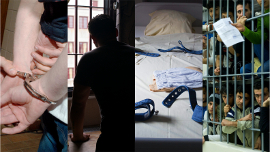“It is inhuman to incarcerate a person for life without any real prospect of release”, said the CPT President Mykola Gnatovskyy. “This does not mean that every prisoner should necessarily be released at some stage, but individual plans and follow-up are essential to evaluate on a case-by-case basis whether and when the person can return to society”.
“We also know from experience that life-sentenced prisoners are not necessarily more dangerous than other prisoners. As a matter of principle, the detention regime of life-sentenced prisoners should never be the automatic result of the type of sentence imposed, but should be decided upon by the prison authorities based on an individual assessment of the prisoner’s situation”, he added.
Although the majority of countries imposing life sentences require that a minimum period of between 20 and 30 years be served before a prisoner may benefit from conditional release, a number of others - including Bulgaria, Lithuania, Malta, the Netherlands and, for certain crimes, Hungary, the Slovak Republic and Turkey - do not have a system of conditional release for life-sentenced prisoners. As a result, some prisoners may never be released (except on compassionate grounds or by pardon).
The CPT urges those states where it has found that conditions for life-sentenced prisoners were particularly harsh to improve their regime. It also reminds states that systematic handcuffing and strip-searching of prisoners or the use of dogs inside the detention area are unacceptable.
The detention regime should keep life-sentenced prisoners in contact with the outside world, offer them the possibility of release into the community under licence and ensure that at some stage their release can be safely granted, at least in most cases. To this end, these prisoners should be given a precise date for the first review for possible release, based on an individual plan defined at the outset of the sentence, and reviewed regularly.
During its visits to member states over the years, the CPT has found that the conditions under which life-sentenced prisoners were held varied significantly from one country to another, and often even from one establishment to another. In many countries, life-sentenced prisoners were held together with other prisoners and benefited from the same rights in terms of work, education, recreational activities, and contact with the outside world.
However, in a number of countries including Armenia, Azerbaijan, Bulgaria, Georgia, Latvia, the Republic of Moldova, Romania, the Russian Federation, Turkey(*) and Ukraine, life-sentenced prisoners were as a rule kept separate from other prisoners.
In some of these countries, the CPT also observed draconian security measures and very limited contact with the outside world, in particular concerning visits. Life-sentenced prisoners were systematically handcuffed and/or strip-searched whenever they left their cells and were sometimes also systematically accompanied by two officers and a guard dog during any movement outside their cell. Prisoners were sometimes locked up for 23 hours a day and could not associate with prisoners from other cells or take part in any purposeful activities.
In recent years, some of these states have improved the detention conditions of life-sentenced prisoners, in particular by offering purposeful activities and more contact with other inmates. However, the CPT considers that much remains to be done to render the situation satisfactory.
In 2014, there were some 27,000 life-sentenced prisoners in Council of Europe member states, according to the Council of Europe Annual Penal Statistics (SPACE).
***
The European Committee for the Prevention of Torture and Inhuman or Degrading Treatment or Punishment (CPT) organises visits to places of detention in the 47 Council of Europe member states in order to assess how persons deprived of their liberty are treated. These places include prisons, juvenile detention centres, police stations, holding centres for immigration detainees, psychiatric hospitals and social care homes. After each visit, the CPT prepares a report containing its findings and recommendations.
-------------------
(*) Only affecting prisoners sentenced to aggravated life imprisonment.



